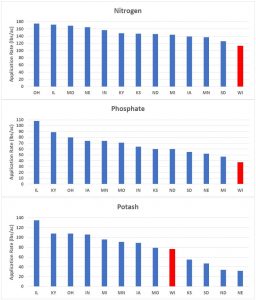The ag news has been dominated by the continuing rise in fertilizer prices. Reported prices for all major types of nitrogen, phosphate, and potash fertilizers increased more than 5% during September.[1] Prices have not been this high in over a decade, though they still have not hit the record highs of 2008.[2] Price increases seem to have slowed in the last few weeks, but it is unclear if more increases will come next spring. With current high grain prices and CFAP payments continuing into 2021, many farmers have been scrambling to buy fertilizer to reduce taxable income for 2021 and to ensure adequate fertilizer for their 2022 crops. Given the uncertainty in fertilizer prices next spring and the availability due to supply chain problems, it seems wise to buy at least some of the fertilizer needed for 2022 now.
Unlike farmers in many states, Wisconsin’s dairy industry helps insulate farmers from these fertilizer price increases by providing manure as an alternative lower cost source of crop fertility needs. The three pot sin Figure 1 show the average application rates of nitrogen, phosphate, and potash fertilizer to corn in the thirteen major north central states in 2018 based on a USDA survey.[3] States are sorted from highest to lowest average application rate.
The plots show that Wisconsin has the lowest average application rate for nitrogen and phosphate among these states and has a below average rate for potash. For example, Wisconsin had an average nitrogen application rate of 113 pounds per acre in 2018 for corn, well below the average of 172 pounds per acre in neighboring Illinois. Similarly, the average phosphate rate in Wisconsin was 37 pounds per acre for corn in 2018, while the average rate in Illinois was 108 pounds per acre.
Dairy manure is the primary reason for these low application rates. Most nitrogen fertilizer used in the state is used for corn, yet about one third of corn nitrogen needs are provided by manure in Wisconsin, almost all from dairy.[4] Other major corn states have large livestock industries, but not relative to the number of corn acres planted each year. Wisconsin farmers annually plant about 4 million acres of corn, with about 1 million used for corn silage, with around 1.25 million dairy cows. The implication is that Wisconsin dairy farmers, who account for a large portion of corn acres in the state, are insulated to some degree from these current fertilizer spikes. However, the insulation effect is not complete and not all the state’s famers will be insulated. Commercial grain farmers in the state without access to manure will not be insulated, nor will potato and vegetable growers and cranberry growers.
Overall, these high fertilizer prices, along with cost increases for most other farm inputs, will reduce farm returns from crop production. But with current expected corn and soybean prices for 2022, most farmers will still enjoy positive margins. Many farms that use dairy manure will be insulated to some extent from these high prices, but not all famers will enjoy this benefit. Nevertheless, all famers will find it valuable to look for ways to use manure and fertilizer more efficiently by using soil and manure testing and following university and science-based guidelines.[5]

Figure 1. State average application rates for key fertilizers used for corn in 2018 (Source: USDA NASS Agricultural Chemical Use Survey https://www.nass.usda.gov/Data_and_Statistics/Pre-Defined_Queries/2018_Peanuts_Soybeans_Corn/)
[1] https://www.dtnpf.com/agriculture/web/ag/crops/article/2021/10/06/fertilizer-price-gains-losing-steam.
[2] https://farmpolicynews.illinois.edu/2021/10/a-profitable-harvest-but-farmers-leery-of-rising-production-costs-and-parts-shortage/.
[3] https://www.nass.usda.gov/Data_and_Statistics/Pre-Defined_Queries/2018_Peanuts_Soybeans_Corn/.
[4] See pages 8 to 13 in https://widnr.widen.net/s/lhcsbgkpsl/uw_nitratereport_091521.